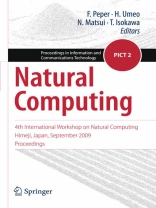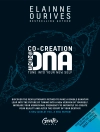Most natural and artificial systems transform information in a predictable or programmable way; such transformation can be interpreted as harnessing nature for computing. Recently we have witnessed a burst of research in unconventional computing, resulting in the development of experimental prototypes of natural computers, plasmodium computers, reaction-diffusion processors, and DNA computers as well as theoretical paradigms of natural computation such as cellular automata, artificial chemistry, evolutionary computing, and neural networks. The International Workshop on Natural Computing (IWNC) brings together computer scientists, biologists, mathematicians, electronic engineers, physicists, and others to critically assess present findings in the field, and to outline future developments in nature-inspired computing. This compilation of papers presented at the most recent workshop, held in Nagoya, Japan, makes a valuable contribution to the understanding of natural computing.
Tabella dei contenuti
Invited Talks.- Investigating Universal Computability of Conventional Cellular Automata Problems on an Organic Molecular Matrix.- Noise-Based Logic and Computing: From Boolean Logic Gates to Brain Circuitry and Its Possible Hardware Realization.- Models and Mechanisms for Artificial Morphogenesis.- Biologically–Inspired Network Architecture for Future Networks.- Foraging Behaviors and Potential Computational Ability of Problem-Solving in an Amoeba.- Two Molecular Information Processing Systems Based on Catalytic Nucleic Acids.- Invited Papers.- The Effect of Community on Distributed Bio-inspired Service Composition.- Efficient Computation in Brownian Cellular Automata.- A Molecular Communication System.- Properties of Threshold Coupled Chaotic Neuronal Maps.- Contributed Papers.- Implementation of Rotary Element with Quantum Cellular Automata.- Universal 2-State Asynchronous Cellular Automaton with Inner-Independent Transitions.- Effect of Population Size in Extended Parameter-Free Genetic Algorithm.- Temperature Effects on Olive Fruit Fly Infestation in the Fly Sim Cellular Automata Model.- Computing by Observing Changes.- Robustness of the Critical Behaviour in a Discrete Stochastic Reaction-Diffusion Medium.- Quantifying the Severity of the Permutation Problem in Neuroevolution.- Extending the Geometrical Design of DNA Nanostructures.- An Optical Solution for the Subset Sum Problem.- Design of True Random One-Time Pads in DNA XOR Cryptosystem.- On Designing Gliders in Three-Dimensional Larger than Life Cellular Automata.- Instability of Collective Flow in Two-Dimensional Optimal Velocity Model.- A New Differential Evolution for Multiobjective Optimization by Uniform Design and Minimum Reduce Hypervolume.- Noise Effects on Chaos in Chaotic Neuron Model.- Applicationof Improved Grammatical Evolution to Santa Fe Trail Problems.- Limit Theorem for a Time-Dependent Coined Quantum Walk on the Line.- Top-Predator Survivor Region Is Affected by Bottom-Prey Mortality Rate on the Monte-Carlo Simulation in Lattice Model.- Simulation and Theoretical Comparison between “Zipper” and “Non-Zipper” Merging.- Universality of 2-State 3-Symbol Reversible Logic Elements — A Direct Simulation Method of a Rotary Element.- Pump Current as a Signal Transformation.- Evaluation of Generation Alternation Models in Evolutionary Robotics.- Photonic Switching of DNA’s Position That Represents the Internal State in Photonic DNA Automaton.- Fluctuation Induced Structure in Chemical Reaction with Small Number of Molecules.- Parallel Retrieval of Nanometer-Scale Light-Matter Interactions for Nanophotonic Systems.- A Compressible Fluid Model for Traffic Flow and Nonlinear Saturation of Perturbation Growth.- Functional Sized Population Magnetic Optimization Algorithm.- Emergence and Collapse of Order in Ad Hoc Cellular Automata.- A Transition Rule Set for the First 2-D Optimum-Time Synchronization Algorithm.- A Two-Dimensional Optimum-Time Firing Squad Synchronization Algorithm and Its Implementation.- Quaternion Based Thermal Condition Monitoring System.- Firing Correlation in Spiking Neurons with Watts–Strogatz Rewiring.- Methods for Shortening Waiting Time in Walking-Distance Introduced Queueing Systems.- Effect of Mutation to Distribution of Optimum Solution in Genetic Algorithm.












